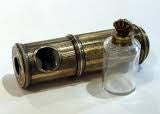A Little Sea Bathing Would Set me up Forever!
Sea Bathing - What was it and who did it?
During Jane Austen's day, taking a holiday by the sea was no uncommon thing. The popularity of towns such as Brighton inspired Jane to write her last, unfinished novel, Sanditon, about a small town with big city aspirations.The Sea air and Sea Bathing together were nearly infallible, one or the other of them being a match for every Disorder... Sanditon, pp.329-30

Sea bathing itself, would prove to be an interesting experience for any young lady bold enough or ill enough to be encouraged to attempt it. Wagons, called Bathing Machines, were invented especially for the purpose, and would be drawn out into the water by sturdy women, who might then assist you down into the water where you could paddle about or swim in relative privacy, shielded from view of the shore.
Jane Austen's cousin, Eliza de Feuillide and her son Hastings spent part of December 1790 through part of January 1791 at the seaside town of Margate. She wrote of her time there, as quoted from JASA's Jane Austen at the Seaside:
I had fixed on going to London the end of this Month, but to shew You how much I am attached to my maternal duties, on being told by one of the faculty whose Skill I have much opinion of that one month’s bathing at this time of the Year was more efficacious than six at any other & that consequently my little Boy would receive the utmost benefit from my prolonging my stay here beyond the time proposed, like a most exemplary parent I resolved on foregoing the fascinating delights of the great City for one month longer ... Was not this heroic? … Hastings grows much & begins to lisp english tolerably well, his education is likewise begun, his Grandmamma having succeeded in teaching him his letters. The Sea has strengthened him wonderfully & I think has likewise been of great service to myself, I still continue bathing notwithstanding the severity of the Weather & Frost & Snow which is I think somewhat courageous. Jane Austen’s ‘Outlandish Cousin’, pp 97-99This seems like extreme sea bathing, though a little frost and snow would be a wonderful treat during these long, hot summer months. Still, what would one wear for such an excursion to the shore? The following fashion plate from August, 1810, offers a glimpse.
 A gown of white French cambric, or pale pink muslin, with long sleeves, and antique cuffs of thin white muslin, trimmed with Mechlen edging; made high in the neck, without a collar, and formed in points at the centre of the bosom, with three rows of letting-in lace; confined down the front of the dress with small buttons; and hemmed round the bottom with three rows of deep Mechlen lace; made rather short, and worn over trowsers of white French cambric, which are trimmed the same as the bottom of the dress. A cap composed of lace and light green silk trimming, tied under the chin, with a bunch of natural flowers in front. Hair in full ringlet curls, divided in the front of the forehead. A figured short scarf of pale buff, with deep pale-green border, and rich silk tassels; worn according to fancy or convenience; with gloves of pale buff kid; and sandals of pale yellow, or white Morocco, complete this truly simple but becoming dress.
A gown of white French cambric, or pale pink muslin, with long sleeves, and antique cuffs of thin white muslin, trimmed with Mechlen edging; made high in the neck, without a collar, and formed in points at the centre of the bosom, with three rows of letting-in lace; confined down the front of the dress with small buttons; and hemmed round the bottom with three rows of deep Mechlen lace; made rather short, and worn over trowsers of white French cambric, which are trimmed the same as the bottom of the dress. A cap composed of lace and light green silk trimming, tied under the chin, with a bunch of natural flowers in front. Hair in full ringlet curls, divided in the front of the forehead. A figured short scarf of pale buff, with deep pale-green border, and rich silk tassels; worn according to fancy or convenience; with gloves of pale buff kid; and sandals of pale yellow, or white Morocco, complete this truly simple but becoming dress.



2 comments
@Catherine Lodgebooks: I’m sorry but I don’t quite understand the purpose of your comment, could you expand?
I found this very amusing – the costume ladies! It was a good thing there were ‘sturdy ladies’ on hand, else you would be struck helpless and swept away with all the lace and inhibitory layering. However, on a serious note, the benefits of cold water swimming are again achieving notoriety in the general populous, thank fully!
Anonymous
Thanks for the pictures, but where ever that one with the white cliffs is (Dover?) it can’t possibly be York. Which is not on the coast and has no cliffs.
Anonymous
Leave a comment
This site is protected by hCaptcha and the hCaptcha Privacy Policy and Terms of Service apply.